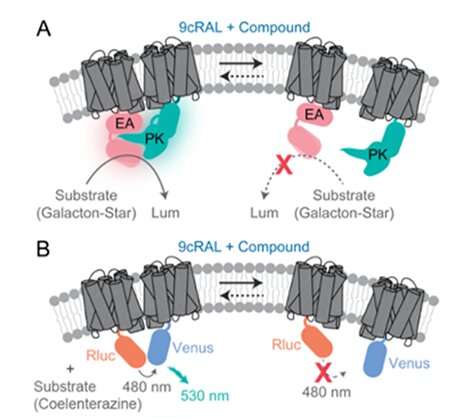Team develops new screening process; could lead to next-generation therapeutics for a broad spectrum of diseases

A new study led by University of California, Irvine researchers developed a high-throughput screen methodology to identify compounds affect a key G protein coupled receptor (GPCR) rhodopsin (Rh). GPCRs mediate many important physiological functions and are considered to be one of the most effective therapeutic targets for a broad spectrum of diseases, ranging from diabetes to immune system disorders.
The study, titled "Identification of small molecule allosteric modulators that act as enhancers/disrupters of rhodopsin oligomerization," was published in the Journal of Biological Chemistry, and provides a monitoring tool for future investigation of the Rh signaling cascade. It also reveals the discovery of new allosteric modulators of Rh dimerization that can also alter the physiology of rod photoreceptors in the eye. The team identified lead compounds that demonstrated allosteric modulation of rod light response kinetics or reduction of rod sensitivity. The next step will be to use medicinal chemistry to improve the pharmacological properties of the lead compounds.
"Our employed methodology will open new avenues for study, tremendously benefitting the discipline of pharmacology by improving understanding of the role of GPCR dimerization," said Krzysztof Palczewski, Ph.D., Donald Bren Professor of Ophthalmology in the UCI School of Medicine and corresponding author. "This approach will also be tested in other GPCR systems such as opioid, adrenergic receptors and others, paving the way to discovery of other more selective modulations of GPCR signaling. These advanced insights result in the identification and production of next-generation medications."
Understanding the functional role of GPCRs, and identifying compounds that either enhance or disrupt the dimerization of the GPCR rhodopsin (Rh), could provide the key to unlock the full potential of these most effective therapeutic targets. Recent studies have shown that many GPCRs exist as dimers and oligomers, and that their organization is an essential requirement for proper operation. The functional role of the dimerization of Rh is currently unknown due to a lack of precise structural information.
Other members of the research team included Tamar Getter, UCI biochemistry of vision post-doctoral fellow; Frans Vinberg, Ph.D., ophthalmology/visual sciences assistant professor; and Albert Kemp, biomedical engineering student, both from the University of Utah, Salt Lake City.
More information: Tamar Getter et al, Identification of small molecule allosteric modulators that act as enhancers/disrupters of rhodopsin oligomerization, Journal of Biological Chemistry (2021). DOI: 10.1016/j.jbc.2021.101401
Journal information: Journal of Biological Chemistry
Provided by University of California, Irvine




















